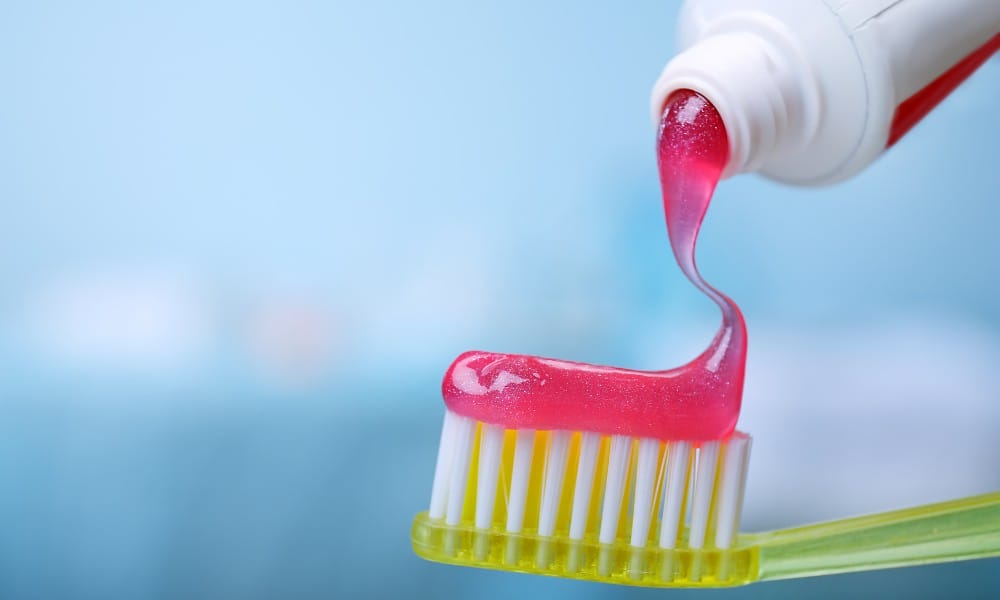For decades, fluoride toothpaste has been a mainstay in oral hygiene routines, championed by dentists and healthcare professionals alike. But recent whispers of potential downsides have some folks wondering if it’s time to ditch the familiar blue stripe in favor of a more natural alternative. So, should you be brushing with worry, or can you confidently continue with your fluoride routine? Let’s separate fact from fiction and explore the science behind fluoride toothpaste and find out if fluoride toothpaste good or bad
The Power of Fluoride: A Natural Defender for Your Smile
Fluoride, a mineral hero found naturally in water and certain foods, acts as your mouth’s shield against cavities. This champion of oral health works its magic in several ways:
Remineralization: Our Teeth’s Superpower Recharge
Imagine your teeth as glistening castles under constant siege. The enemy? Acidic attacks are launched by sneaky bacteria in your mouth. These assaults can weaken and erode tooth enamel, the hard, protective outer layer of your teeth. But fear not! Fluoride swoops in like a knight in shining armor. It strengthens enamel by replacing lost minerals, acting like tiny bricks to rebuild your defenses. This remineralization process makes your teeth more resistant to decay, keeping your smile strong and healthy.
Fight the Plaque Force: Keeping Your Smile Squeaky Clean
Plaque, the sticky film that forms on your teeth, is the villain’s lair, harboring those cavity-causing bacteria. But fluoride disrupts their evil plans! By interfering with the bacteria’s ability to grow and multiply, fluoride hinders plaque formation. This weakens the villain’s forces, making it harder for them to erode your teeth and cause cavities.
Safety First: Weighing the Concerns
Fluoride toothpaste has been a mainstay in oral hygiene for decades, with well-documented benefits in preventing cavities and strengthening teeth. However, some concerns linger, particularly for parents and individuals with underlying health conditions. Let’s delve deeper into these considerations:
Fluorosis: Understanding the Spotty Picture
- Excessive Fluoride Intake: The primary concern is fluorosis, a condition caused by ingesting too much fluoride during tooth development (childhood).
- Enamel’s Vulnerability: When exposed to high fluoride levels, the developing tooth enamel can become hypomineralized. This weakens the enamel, leading to the appearance of white spots or streaks on the teeth.
- Severity Spectrum: Fluorosis can range from mild cosmetic changes (white dots) to more severe cases with brown discoloration or pitting of the tooth surface.
Swallowing Concerns: Minimizing Toothpaste Troubles for Tots
- Developmental Hurdle: Young children are still mastering the art of proper brushing and spitting. This can lead to accidental ingestion of toothpaste, especially for those under 6 years old.
- Fluoride Concentration: While the amount of fluoride in toothpaste is generally safe for adults, frequent swallowing by young children can increase their fluoride intake and contribute to fluorosis.
Beyond the Teeth: Exploring Potential Health Links
- Emerging Research: Some studies have suggested a possible link between high fluoride consumption and other health issues. This includes skeletal fluorosis (weakening of bones) and certain neurological problems.
- Need for Confirmation: It’s important to note that this research is ongoing, and more data is needed to confirm a definitive cause-and-effect relationship.
- Dosage Matters: The levels of fluoride used in public water fluoridation and toothpaste are typically well below any potential risk thresholds.
How to Get the Most Out of Fluoride Toothpaste
The American Dental Association (ADA) and other leading health organizations recommend fluoride toothpaste for both children and adults as a safe and effective way to prevent cavities. Here are some tips for getting the most out of your fluoride routine:
Choosing the Right Toothpaste
- Look for the ADA Seal: This seal signifies that the toothpaste has been rigorously tested and meets the ADA’s standards for safety and effectiveness in preventing cavities.
- Consider Your Needs: Many fluoride toothpastes offer additional benefits like tartar control, gum health protection, or whitening. Choose one that addresses your specific concerns.
- Read the Label: Pay attention to the fluoride concentration (ppm – parts per million). Generally, higher concentrations offer more protection, but consult your dentist for the best option for you, especially for children.
Age-Appropriate Use
- Tiny Tots (Under 3): Use a rice-sized smear of fluoride toothpaste specifically designed for infants and toddlers. These often have a milder flavor to encourage acceptance. Close supervision during brushing is crucial to prevent swallowing.
- Preschool Power Brushers (Ages 3-6): Gradually increase the amount of toothpaste to a pea-sized amount as your child develops better coordination and brushing skills. Continue to supervise brushing and emphasize spitting, not swallowing.
Brushing Technique Matters
- Time it Right: Brush for a full two minutes twice a day. Many electric toothbrushes have timers to help you reach this goal.
- Reach Every Nook and Cranny: Use a soft-bristled brush and gentle motions to clean all surfaces of your teeth, including the front, back, and chewing surfaces. Remember those hard-to-reach areas behind your front teeth!
- Target the Tongue: Brushing your tongue helps remove bacteria and freshen your breath.
- The Right Angle: Tilt your brush at a 45-degree angle against your gum line to effectively clean both the teeth and gums.
- Flossing Matters: Flossing once a day removes plaque and debris from between teeth where brushing can’t reach.
Complement, Don’t Replace
Fluoride toothpaste is a superhero, but it needs a team! Regular dental checkups and professional cleanings are still essential for optimal oral health. Your dentist can identify and address any potential problems early on. Also, diet plays an important role: Limit sugary drinks and snacks, which can contribute to cavities.
Fluoride Alternatives: Exploring Options for Oral Care
If you’re considering alternatives to fluoride toothpaste, here’s a detailed look at what you need to know:
Fluoride-Free Options
- Natural Ingredients: Many fluoride-free toothpastes contain natural ingredients like xylitol, a sugar alcohol that can help reduce plaque buildup and fight bacteria. Some may also include miswak, a natural twig used for centuries to clean teeth, or neem, an herb with potential antibacterial properties.
- Focus on Specific Needs: Looking for fresh breath? Certain fluoride-free toothpastes include essential oils like peppermint or spearmint for a long-lasting minty taste. If teeth sensitivity is a concern, some options contain ingredients like potassium nitrate to help soothe discomfort.
Effectiveness Considerations
- Reduced Cavity Protection: While fluoride-free toothpastes may offer some plaque control and freshen breath, they generally lack the proven effectiveness of fluoride in preventing cavities. Fluoride strengthens tooth enamel and helps repair early signs of decay.
- Importance of Brushing and Flossing: Without fluoride’s cavity-fighting benefits, a meticulous oral hygiene routine becomes even more critical. Brushing for two minutes twice a day, with proper flossing, becomes essential to remove plaque and food particles.
- Diet and Other Risk Factors: Sugary foods and drinks contribute significantly to cavities. If you have a diet high in these or other risk factors like dry mouth, consider the potential drawbacks of fluoride-free toothpaste more carefully.
Consulting Your Dentist
- Individual Needs: Every person’s oral health needs are unique. Your dentist can assess your risk factors for cavities, your dental history, and your flossing habits. They can then advise you on whether a fluoride-free toothpaste is a suitable choice for you.
- Alternative Recommendations: If you have concerns about fluoride but still prioritize cavity prevention, your dentist might recommend other options like fluoride mouthwash or professional fluoride treatments.
Fluoride toothpaste is generally safe and effective for most people, especially when used correctly. The benefits of cavity prevention outweigh the risks for adults and children with developed swallowing reflexes. However, if you’re concerned about fluoride intake, particularly for young children, there are safe and effective fluoride-free toothpastes available. The key is to maintain a consistent oral hygiene routine that includes brushing, flossing, and regular dental checkups, regardless of whether you use fluoride toothpaste. If you have any questions or concerns about fluoride toothpaste, talk to your dentist. They can advise you on the best course of action for your individual needs.

